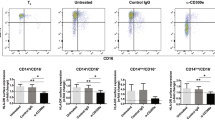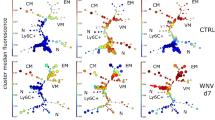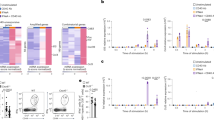Abstract
NKG2D is an activating receptor that stimulates innate immune responses by natural killer cells upon engagement by MIC ligands, which are induced by cellular stress. Because NKG2D is also present on most CD8αβ T cells, it may modulate antigen-specific T cell responses, depending on whether MIC molecules—distant homologs of major histocompatibility complex (MHC) class I with no function in antigen presentation—are induced on the surface of pathogen-infected cells. We found that infection by cytomegalovirus (CMV) resulted in substantial increases in MIC on cultured fibroblast and endothelial cells and was associated with induced MIC expression in interstitial pneumonia. MIC engagement of NKG2D potently augmented T cell antigen receptor (TCR)-dependent cytolytic and cytokine responses by CMV-specific CD28− CD8αβ T cells. This function overcame viral interference with MHC class I antigen presentation. Combined triggering of TCR-CD3 complexes and NKG2D induced interleukin 2 production and T cell proliferation. Thus NKG2D functioned as a costimulatory receptor that can substitute for CD28.
This is a preview of subscription content, access via your institution
Access options
Subscribe to this journal
Receive 12 print issues and online access
$209.00 per year
only $17.42 per issue
Buy this article
- Purchase on SpringerLink
- Instant access to full article PDF
Prices may be subject to local taxes which are calculated during checkout







Similar content being viewed by others
References
Germain, R. N. & Margulies, D. H. The biochemistry and cell biology of antigen processing and presentation. Annu. Rev. Immunol. 11, 403–450 (1993).
Davis, M. M. et al. Ligand recognition by αβ T cell receptors. Annu. Rev. Immunol. 16, 523–544 (1998).
Lenschow, D. J., Walunas, T. L. & Bluestone, J. A. CD28/B7 system of T cell costimulation. Annu. Rev. Immunol. 14, 233–258 (1996).
Hara, T., Fu, S. M. & Hansen, J. A. Human T cell activation. II. A new activation pathway used by a major T cell population via a disulfide-bonded dimer of a 44 kilodalton polypeptide (9.3 antigen). J. Exp. Med. 161, 1513–1524 (1985).
Thompson, C. B. et al. CD28 activation pathway regulates the production of multiple T cell-derived lymphokines/cytokines. Proc. Natl Acad. Sci. USA 86, 1333–1337 (1989).
Gimmi, C. D. et al. B-cell surface antigen B7 provides a costimulatory signal that induces T cells to proliferate and secrete interleukin 2. Proc. Natl Acad. Sci. USA 88, 6575–6579 (1991).
Linsley, P. S. et al. Binding of the B cell activation antigen B7 to CD28 costimulates T cell proliferation and interleukin 2 mRNA accumulation. J. Exp. Med. 173, 721–730 (1991).
Harding, F. A., McArthur, J. G., Gross, J. A., Raulet, D. H. & Allison, J. P. CD28-mediated signalling co-stimulates murine T cells and prevents induction of anergy in T cell clones. Nature 356, 607–609 (1992).
Gribben, J. G. et al. CTLA-4 mediates antigen-specific apoptosis of human T cells. Proc. Natl Acad. Sci. USA 92, 811–815 (1995).
Chambers, C. A. & Allison, J. P. Costimulatory regulation of T cell function. Curr. Opin. Cell Biol. 11, 203–210 (1999).
Ravetch, J. V. & Lanier, L. L. Immune inhibitory receptors. Science 290, 84–89 (2000).
Lee, N. et al. HLA-E is the major ligand for the natural killer inhibitory receptor CD94/NKG2A. Proc. Natl Acad. Sci. USA 95, 5199–5204 (1998).
Long, E. O. Regulation of immune responses through inhibitory receptors. Annu. Rev. Immunol. 17, 875–904 (1999).
Lanier, L. L., Corliss, B. C., Wu, J., Leong, C. & Phillips, J. H. Immunoreceptor DAP12 bearing a tyrosine-based activation motif is involved in activating NK cells. Nature 391, 703–707 (1998).
Lanier, L. L. Turning on natural killer cells. J. Exp. Med. 191, 1259–1262 (2000).
Phillips, J. H., Gumperz, J. E., Parham, P. & Lanier, L. L. Superantigen-dependent, cell-mediated cytotoxicity inhibited by MHC class I receptors on T lymphocytes. Science 268, 403–405 (1995).
Carena, I., Shamshiev, A., Donda, A., Colonna, M. & De Libero, G. Major histocompatibility complex class I molecules modulate activation threshold and early signaling of T cell antigen receptor-γδ stimulated by nonpeptide ligands. J. Exp. Med. 186, 1769–1774 (1997).
Ikeda, H. et al. Characterization of an antigen that is recognized on a melanoma showing partial HLA loss by CTL expressing an NK inhibitory receptor. Immunity 6, 199–208 (1997).
Bakker, A. B. H., Phillips, J. H., Figdor, C. G. & Lanier, L. L. Killer cell inhibitory receptors for MHC class I molecules regulate lysis of melanoma cells mediated by NK cells,γδ T cells, and antigen-specific CTL. J. Immunol. 160, 5239–5245 (1998).
Noppen, C. et al. C-type lectin-like receptors in peptide-specific HLC class I-restricted expression and modulation of effector functions in clones sharing identical TCR structure and epitope specificity. Eur. J. Immunol. 28, 1134–1142 (1998).
Houchins, J. P., Yabe, T., McSherry, C. & Bach, F. H. DNA sequence analysis of NKG2, a family of related cDNA clones encoding type II integral membrane proteins on human natural killer cells. J. Exp. Med. 173, 1017–1020 (1991).
Bauer, S. et al. Activation of NK cells and T cells by NKG2D, a receptor for stress-inducible MICA. Science 285, 727–729 (1999).
Wu, J. et al. An activating immunoreceptor complex formed by NKG2D and DAP 10. Science 285, 730–732 (1999).
Bahram, S., Bresnahan, M., Geraghty, D. E. & Spies, T. A second lineage of mammalian major histocompatibility complex class I genes. Proc. Natl Acad. Sci. USA 91, 6259–6263 (1994).
Bahram, S. & Spies, T. Nucleotide sequence of a human MHC class I MICB cDNA. Immunogenetics 43, 230–233 (1996).
Groh, V. et al. Cell stress-regulated human major histocompatibility complex class I gene expressed in gastrointestinal epithelium. Proc. Natl Acad. Sci. USA 93, 12445–12450 (1996).
Li, P. et al. Crystal structure of the MHC class I homolog MIC-A, aγδ T cell ligand. Immunity 10, 577–584 (1999).
Groh, V., Steinle, A., Bauer, S. & Spies, T. Recognition of stress-induced MHC molecules by intestinal epithelialγδ T cells. Science 279, 1737–1740 (1998).
Groh, V. et al. Broad tumor-associated expression and recognition by tumor-derivedγδ T cells of MICA and MICB. Proc. Natl Acad. Sci. USA 96, 6879–6884 (1999).
Kao, H. T. & Nevins, J. R. Transcriptional activation and subsequent control of the human heat shock gene during adenovirus infection. Mol. Cell. Biol. 3, 2058–2065 (1983).
Khandjian. E. W. & Türler, H. Simian virus 40 and polyomavirus induce synthesis of heat shock proteins in mammalian cells. Mol. Cell. Biol. 3, 1–8 (1983).
LaThangue, N. B. & Latchman, D. S. Nuclear accumulation of a heat-shock 70-like protein during herpes simplex virus replication. Biosci. Rep. 7, 475–483 (1987).
Santomenna, L. D. & Colberg-Poley, A. M. Induction of cellular hsp70 expression by human cytomegalovirus. J. Virol. 64, 2033–2040 (1990).
Ploegh, H. L. Viral strategies of immune evasion. Science 280, 248–253 (1998).
Riddell, S. R. et al. Restoration of viral immunity in immunodeficient humans by the adoptive transfer of T cell clones. Science 257, 238–241 (1992).
Riddell, S. R. Pathogenesis of cytomegalovirus pneumonia in immunocompromised hosts. Sem. Resp. Infect. 10, 199–208 (1995).
McLaughlin-Taylor, E. et al. Identification of the major late human cytomegalovirus matrix protein pp65 as a target antigen for CD8+ virus-specific cytotoxic T lymphocytes. J. Med. Virol. 43, 103–110 (1994).
Gilbert, M. J., Riddell, S. R., Plachter, B. & Greenberg, P. D. Cytomegalovirus selectively blocks antigen processing and presentation of its immediate-early gene product. Nature 383, 720–722 (1996).
Parham, P., Barstable, C. J. & Bodmer, W. F. Use of a monoclonal antibody (W6/32) in structural studies of HLA-A, B, C antigens. J. Immunol. 123, 342–349 (1979).
Azuma, M., Phillips, J. H. & Lanier, L. L. CD28− T lymphocytes – antigenic and functional properties. J. Immunol. 150, 1147–1159 (1993).
Chalupny, J. et al. Soluble forms of the novel MHC class I-related molecules ULBP1 and ULBP2 bind to, and functionally activate NK cells. FASEB J. 14, A1018 (2000).
Posnett, D. N., Edinger, J. W., Manavalan, J. S., Irwin, C. & Marodon, G. Differentiation of human CD8 T cells: implications for in vivo persistence of CD8+ CD28− cytotoxic effector clones. Int. Immunol. 11, 229–241 (1999).
Cerwenka, A. et al. Retinoic acid early inducible genes define a ligand family for the activating NKG2D receptor in mice. Immunity 12, 721–727 (2000).
Diefenbach, A., Jamieson, A. M., Liu, S. D., Shastri, N. & Raulet, D. H. Ligands for the murine NKG2D receptor: expression by tumor cells and activation of NK cells and macrophages. Nature Immunol. 1, 119–126 (2000).
Waldmann, W. J., Sneddon, J. M., Stephens, R. E. & Roberts, W. H. Enhanced endothelial cytopathogenicity induced by a cytomegalovirus strain propagated in endothelial cells. J. Med. Virol. 28, 223–230 (1989).
Wills, M. R. et al. The human cytotoxic T-lymphocyte (CTL) response to cytomegalovirus is dominated by structural protein pp65: frequency, specificity, and T cell receptor usage of pp65-specific CTL. J. Virol. 70, 7569–7579 (1996).
Altman, J. D. et al. Phenotypic analysis of antigen specific T lymphocytes. Science 274, 94–98 (1996).
Callan, M. F. et al. Direct visualization of CD8+ T cells during the primary immune response to Epstein-Barr virus in vivo. J. Exp. Med. 187, 1395–1402 (1998).
Acknowledgements
We thank L. De Jong for assistance; C. Yee for helpful discussions; D. Myerson for tissue specimens; and M. Lopez-Botet and L. Lanier for antibodies. J. R.-H. thanks B. Torok-Storb for support through National Institutes of Health (NIH) grant CA18221. Supported by a Cancer Research Institute Junior Council Fellowship (to M. S. T.) and NIH grants CA18029 and AI41754 (to S. R. R.) and CA18221 and AI30581 (to T. S.).
Author information
Authors and Affiliations
Corresponding authors
Rights and permissions
About this article
Cite this article
Groh, V., Rhinehart, R., Randolph-Habecker, J. et al. Costimulation of CD8αβ T cells by NKG2D via engagement by MIC induced on virus-infected cells. Nat Immunol 2, 255–260 (2001). https://doi.org/10.1038/85321
Received:
Accepted:
Issue Date:
DOI: https://doi.org/10.1038/85321



